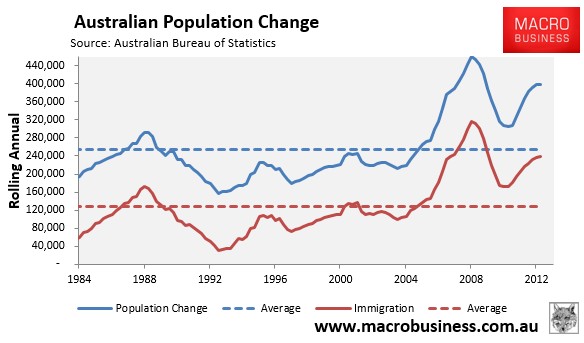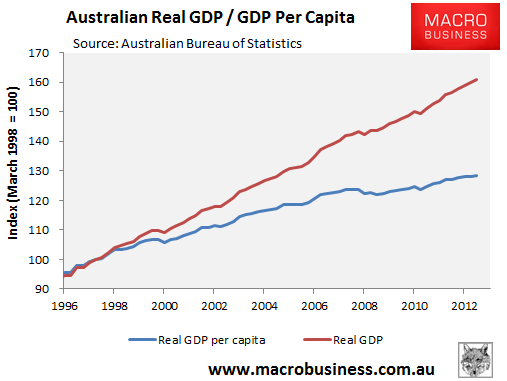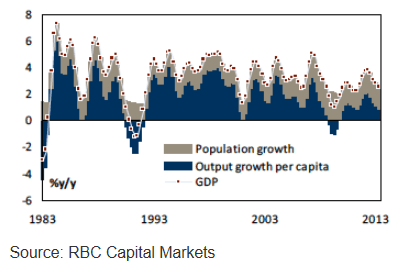
Yesterday. Fairfax’s Michael Pascoe asked the salient question: Is Australia ready for 2.3 million more people:
Despite all the headlines, it’s not the boat people we need to worry about – it’s the other 2.3 million arriving… when public investment in the nation is at an all-time low. That’s the investment necessary to accommodate the increased population and maintain our quality of life. Or not…
The nation’s infrastructure, especially public transport, is groaning under its present load yet we’re adding 2.3 million over the next five years…
Thus there’s a difficult contradiction at the heart of the new government. It aspires to small government, but it is responsible for a growth country that requires greater public investment. There is a potentially dangerous faith that everything can be left to the private sector to fix, but our duopoly and oligopoly-riddled private sector doesn’t make for the purest of market mechanisms.
The simple answer to Pascoe’s question is an unequivocal no. At the current rate of population growth – the lion’s share of which is via immigration – Australia’s population is set to grow by 10% over the next five years, putting further pressure on Australia’s already strained infrastructure.

As shown in the above chart, the problem began under the Howard Government wh0, despite talking tough on asylum seekers, dramatically increased Australia’s immigration program in the mid-2000s. This approach gained bipartisan support, with the Rudd/Gillard Governments embracing high immigration (remember Rudd’s “Big Australia” boast), and now both sides of politics want it maintained (actually, Opposition Leader, Bill Shorten, has argued for a significant increase in immigration intake).
The key reason for advocating ongoing high immigration is perhaps best summed-up by the next chart, which shows how high population growth juices headline GDP (more inputs of people equals more outputs), which enables governments to claim that they are strong economic managers:
Remove population growth from the equation, however, and you can see that GDP growth in Australia has been lacklustre ever since the Global Financial Crisis, and that Australia did in fact experience a recession in per capita terms in 2008.

What seems to be lost on the Government is that in a material living standards sense, it is growth in GDP per capita that matters. After all, what’s the point of growing the economic pie through immigration if everyone’s share of that pie remains unchanged (or falls)?
The question around living standards becomes all the more important when infrastructure constraints and the environment are taken into account.
Indeed, as highlighted by Pascoe above, a big negative of Australia’s high rate of population growth is that it is placing increasing pressure on the pre-existing (already strained) stock of infrastructure and housing, which reduces productivity and living standards unless costly new investments are made. Further, controversial investments like desalination plants would arguably not have been required absent such population growth.
Further, when infrastructure and housing investment fails to keep up, it places upward pressure on inflation, requiring higher interest rates, which can then damage productive sectors of the economy. As explained in a 2011 speech by the Reserve Bank of Australia’s Phil Lowe (summarised here), these factors were certainly in play in the late-2000s, when rapid population growth placed upward pressure on rents, as well as a big surge in utilities prices as the capacity of the system struggled to keep pace with the growing demand, requiring costly new investments.
Ongoing high population growth also places additional strain on the natural environment, causing greater environmental degradation, increasing water scarcity and pollution, and making it more difficult for Australia to reduce its carbon footprint and meet international pollution reduction targets.
Lets also not forget that Australia earns its way in the world mainly by selling its fixed mineral resources (e.g. iron ore, coal, natural gas, and gold). More people means less resources per capita. A growing population also means that we must deplete our mineral resources faster just to maintain a constant standard of living.
So why, then, are Australia’s politicians continuing to follow the high immigration path when the benefits to the pre-existing population are so questionable?
Well, apart from juicing headline GDP growth (explained above), high immigration allows the Government to delay the costs of an ageing population by replacing retiring baby boomers with new blood. However, such an approach is also spurious, since importing more workers only delays the ageing problem, pushing it onto future generations. The migrants that arrive today will also grow old, retire and need taxpayer support, requiring another larger influx of immigrants to offset their departure from the labour force.
Perhaps the bigger factor is the Government’s desire to appease big business. As noted by Pascoe above, Australia is ruled by duopolies and oligopolies, which see a rising population as an easy way of selling more goods and services. Big business also receives, through immigration, access to lower cost workers. And there’s less need to become more efficient when your customer base is growing inexorably. Rather, just sit back and watch the profits flow.
The situation is perhaps most pervasive for Australia’s banks, which get the double bonus of not just having more consumers to sell debt to, but also extra demand for housing, which helps to support house prices and their loan collateral, especially given the urban consolidation policies operated by Australia’s states. No wonder their share prices are at record highs!
However, while the big end of town is the clear winner from rapid population growth, it doesn’t wear many of the costs. That is borne by you and I.
As argued previously, while I believe that Australia could probably support a substantially larger population with improved policy settings and investment, like many Australians, I don’t hold much faith in our political class or policy making processes, which have time and again proven to be deficient in providing adequately for the pre-existing population (let also tens of millions more people), or that a substantially larger population would improve living standards anyway.


